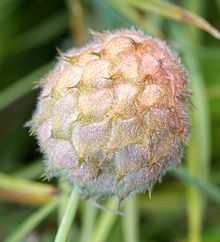Trifolium fragiferum
| Trifolium fragiferum | |
|---|---|
 | |
| Scientific classification | |
| Kingdom: | Plantae |
| (unranked): | Angiosperms |
| (unranked): | Eudicots |
| (unranked): | Rosids |
| Order: | Fabales |
| Family: | Fabaceae |
| Subfamily: | Faboideae |
| Tribe: | Trifolieae |
| Genus: | Trifolium |
| Species: | T. fragiferum |
| Binomial name | |
| Trifolium fragiferum L. | |
Trifolium fragiferum is a species of clover known by the common name strawberry clover. It is native to Europe, Asia, and parts of Africa. It is present in other places, such as sections of North America, as an introduced species. It is also cultivated as a cover crop and for hay and silage, as green manure, and as a bee plant.[1][2] It is good for cover on flood-prone lands or areas with soil salinity. It is known as a weed in some areas.[3] This is a perennial herb that spreads via stolons to form mats or clumps of herbage. The leaves are borne on long petioles. Each blade is made up of usually three serrated oval leaflets up to 2 to 2.5 centimeters long. The inflorescence is a head of flowers around a centimeter long when first flowering. It increases in size to two centimeters as the fruits develop, the sepals becoming thin and inflated, fuzzy and pinkish in color, to resemble a strawberry[1] or raspberry.[3]
Several agricultural cultivars have been developed, including 'Salina', 'Palestine', and 'Fresa'.[1]
| Wikimedia Commons has media related to Trifolium fragiferum. |
References
- ↑ 1.0 1.1 1.2 FAO Crop Profile
- ↑ Sustainable Agriculture Research and Education Program. University of California.
- ↑ 3.0 3.1 UC Davis IPM